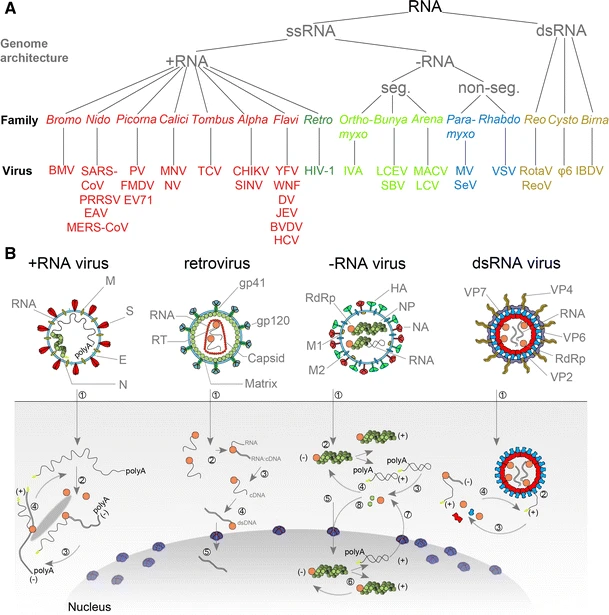RNA viruses, a vast and diverse taxonomic group, have captivated the scientific community for decades. Their unique genetic makeup, replication strategies, and propensity for rapid evolution make them both fascinating subjects of study and formidable pathogens. This blog delves into the intricate world of RNA viruses, exploring their characteristics, classification, and the complexities they present.
The RNA Architecture:
Unlike their DNA-wielding counterparts, RNA viruses possess ribonucleic acid (RNA) as their genetic material. This RNA can be either single-stranded (ssRNA) or double-stranded (dsRNA), further classified based on polarity. Positive-sense (+ssRNA) RNA acts as messenger RNA (mRNA) for the host cell, while negative-sense (-ssRNA) requires an RNA-dependent RNA polymerase (RdRp) for generating mRNA.
Replication Redefined:
The replication cycle of RNA viruses diverges significantly from DNA viruses. Due to the absence of a proofreading mechanism in their RNA-dependent RNA polymerase (RdRp), RNA viruses exhibit high mutation rates. This inherent genetic variability fuels their rapid evolution, allowing them to adapt to new environments and evade host immune responses.
A Taxonomic Tapestry:
The Baltimore classification system categorizes viruses based on their genome structure and replication strategy. Grouped under Classes I-V, RNA viruses occupy Classes III-V. Class III encompasses double-stranded RNA (dsRNA) viruses, while Classes IV and V represent positive-sense and negative-sense single-stranded RNA viruses, respectively. This classification system provides a framework for understanding the intricate diversity within the realm of RNA viruses.
A Spectrum of Pathogenicity:
RNA viruses are implicated in a wide array of human diseases, ranging from the common cold caused by rhinoviruses to the devastating hemorrhagic fevers like Ebola virus disease. Their ability to mutate rapidly makes vaccine development challenging, necessitating constant scientific vigilance and adaptation.
Conclusion: The Enduring Challenge:
RNA viruses pose a continuous threat to human health due to their unique genetic makeup, error-prone replication, and remarkable capacity for evolution. Unveiling the intricacies of these viral adversaries is paramount for developing effective diagnostics, therapeutics, and preventive strategies. As research delves deeper into the world of RNA viruses, we inch closer to mitigating their impact and safeguarding global health.


